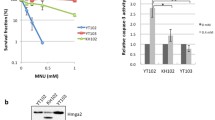Abstract
ACQUIRED resistance to alkylating agents such as N-methyl-N-nitrosourea or N-methyl-N′ -nitro-N-nitrosoguanidine results from the ability to tolerate the potentially cytotoxic methylated base O6-methylguanine (m6-G) in DNA. In the absence of repair by demethylation in situ, m6-G is probably lethal through its inappropriate processing by the cell1. DNA mismatch correction is an attractive candidate for the processing function because although it is replicated, m6-G has no perfect complementary base. Thus, m6-G in DNA might provoke abortive mismatch repair and tolerance could subsequently arise through loss of a mismatch repair pathway2,3. Mismatch correction helps maintain genomic fidelity by removing misincorporated bases and deaminated 5-methylcytosine from DNA, and its loss by mutation confers a mutator phenotype on Escherichia coli4,5. Here we describe human and hamster cell lines that are tolerant to N-methyl-N-nitrosourea and are defective in a DNA mismatch binding activity. The loss of this activity, which acts on G-T mispairs, confers a mutator phenotype.
Similar content being viewed by others
References
Karran, P. & Bignami, M. Nucleic Acids Res. 20, 2933–2940 (1992).
Karran, P. & Marinus, M. G. Nature 296, 868–869 (1982).
Goldmacher, V. S., Cuzick, R. A. & Thilly, W. G. J. biol. Chem. 261, 12462–12471 (1986).
Cox, E. C. A. Rev. genet. 10, 135–156 (1976).
Lieb, M. Genetics 128, 23–27 (1991).
Karran, P., Stephenson, C., Macpherson, P., Cairns-Smith, S. & Priestley, A. Cancer Res. 50, 1532–1537 (1990).
Aquilina, G. et al. Carcinogenesis 9, 1217–1222 (1988).
Aquilina, G., Zijno, A., Moscufo, N., Dogliotti, E. & Bignami, M. Carcinogenesis 10, 1219–1223 (1989).
Jiricny, J., Hughes, M., Corman, N. & Rudkin, B. B. Proc. natn. Acad. Set. U.S.A. 85, 8860–8864 (1988).
Stephenson, C. & Karran, P. J. biol. Chem. 264, 21177–21182 (1989).
Borts, R. H. et al. Genetics 124, 573–584 (1990).
Phear, G., Armstrong, W. & Meuth, M. J. molec. Biol. 209, 577–582 (1989).
McGregor, W. G., Maher, V. M. & McCormick, J. J. Somatic Cell and Molecular Genetics 17, 463–469 (1991).
Rewinski, C. & Marinus, M. G. Nucleic Acids Res. 15, 8205–8215 (1987).
Schaaper, R. M. & Dunn, R. L. Proc. natn. Acad. Sci. U.S.A. 84, 6220–6224 (1987).
Fleck, O., Michael, H. & Heim, L. Nucleic Acids Res. 20, 2271–2278 (1992).
Fujii, H. & Shimada, T. J. biol. Chem. 264, 10057–10064 (1989).
Linton, J. P. et al. Molec. cell. Biol. 9, 3058–3072 (1989).
Modrich, P. J. biol. Chem. 264, 6597–6600 (1989).
Luria, S. E. & Delbrück, M. Genetics 28, 491–511 (1943).
Lea, D. E. & Coulson, C. A. J. Genet. 49, 264–285 (1949).
Author information
Authors and Affiliations
Rights and permissions
About this article
Cite this article
Branch, P., Aquilina, G., Bignami, M. et al. Defective mismatch binding and a mutator phenotype in cells tolerant to DNA damage. Nature 362, 652–654 (1993). https://doi.org/10.1038/362652a0
Received:
Accepted:
Issue Date:
DOI: https://doi.org/10.1038/362652a0
- Springer Nature Limited
This article is cited by
-
A specific mode of microsatellite instability is a crucial biomarker in adult T-cell leukaemia/lymphoma patients
Journal of Cancer Research and Clinical Oncology (2017)
-
Apoptosome activation, an important molecular instigator in 6-mercaptopurine induced Leydig cell death
Scientific Reports (2015)
-
YB-1 disrupts mismatch repair complex formation, interferes with MutSα recruitment on mismatch and inhibits mismatch repair through interacting with PCNA
Oncogene (2014)
-
Balancing repair and tolerance of DNA damage caused by alkylating agents
Nature Reviews Cancer (2012)
-
Somatic deletions of genes regulating MSH2 protein stability cause DNA mismatch repair deficiency and drug resistance in human leukemia cells
Nature Medicine (2011)





